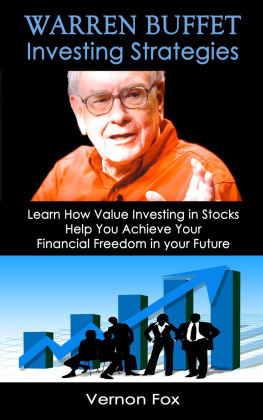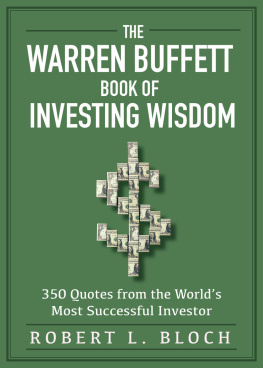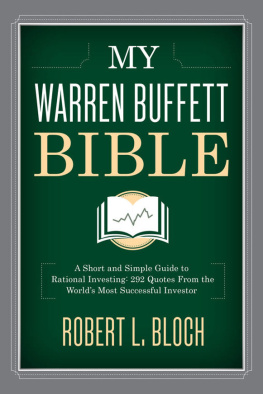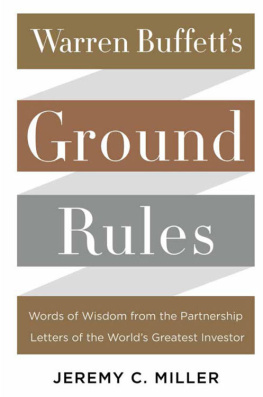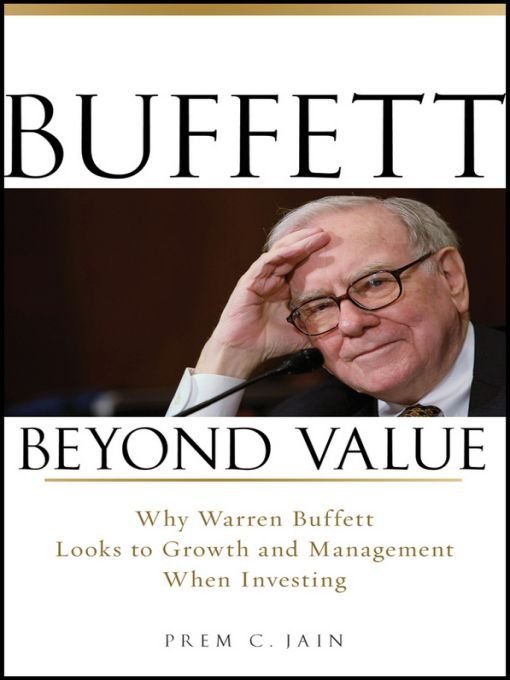
Table of Contents
List of Tables
- Appendix: A Summary of the Book
- Chapter 3: Value InvestingIts Like Buying Christmas Cards in January
- Chapter 4: Growth Investing
- Chapter 5: Intrinsic Value
- Chapter 6: Buffett Investing = Value + Growth
- Chapter 7: Insurance: Other Peoples Money
- Chapter 8: Reinsurance: More of Other Peoples Money
- Chapter 10: If You Dont Know Jewelry, Know Your Jeweler
- Chapter 12: Why Invest in Utility Companies?
- Chapter 13: High Profits in Honest-to-Goodness Manufacturing Companies
- Chapter 20: M = Monopoly = Money
- Chapter 22: Property, Plant, and Equipment: Good or Bad?
- Chapter 23: Key to Success: ROE and Other Ratios
- Chapter 24: Accounting Goodwill: Is It Any Good?
- Chapter 27: Dividends: Do They Make Sense in This Day and Age?
- Chapter 28: Should You Invest in Companies That Repurchase Their Own Shares?
List of Illustrations
- Chapter 1: The Thrill of Investing in Common Stocks
- Chapter 3: Value InvestingIts Like Buying Christmas Cards in January
- Chapter 9: Tax Deferment: Interest-Free Loans from the Government
- Chapter 16: Diversification: How Many Baskets Should You Hold?
- Chapter 20: M = Monopoly = Money
Guide
Pages
Buffett Beyond Value
Why Warren Buffett Looks to Growth and Management When Investing
Prem C. Jain
Preface
This book is for everyone with a serious interest in learning about stock market investing using principles espoused by Warren Buffett. Just over 20 years ago, while teaching at the Wharton School, I stumbled upon an essay by Warren Buffett that motivated me to carefully investigate his investment style. I was intrigued when I realized that there was a fundamental difference between Buffetts attitude toward investing and the academic approach. While academics generally anchor on the impossibility of making above-average returns, Buffett proposes just the opposite. He argues that with a careful study of company fundamentals and management quality, investors definitively can earn above-average returns. His outstanding long-term record supports his claim. When faced with Buffetts record, most academics either dismiss it as an outlier or brand him a genius who cannot be copied or explained. I wanted to know if there was a systematic way of understanding and emulating his investment philosophy.
Most authors, including academics, characterize Buffett as a value investor. Buffett is not just a value investorat least not in the popular sense that the value moniker is used. Buffetts publicly traded company, Berkshire Hathaway, has grown at an annualized rate of about 20 percent in assets, revenues, net worth, and market value for 44 years. His performance is closer to what would be expected from a successful growth investor. Unlike other businessmen who may have also amassed great fortunes, Buffett stands alone because his long-term success reflects growth of his business and investments in several different industries without ever riding a hot trend. There is another major difference between Buffett and other successful investors, which is actually the main reason I chose to study him diligently. Warren Buffett is a man of the highest level of integrity. He knows that he has a special gift, and instead of keeping it to himself, he has chosen to share his immensely valuable experiences with anyone who cares to do some research. A remarkable teacher, Buffett has written a considerable body of material on his ideas and principles, which allows for careful examination of his strategies and motivations.
The key reason for Buffetts unparalleled success is not only his ability to stay resolute with the primary value investing principle of maintaining a low downside risk but also his skill at pairing it with the growth investing principle of putting money into companies with sustainable growth opportunities. Thus, he combines the principles of both the value and growth investment strategies. Yet, he does not invest in high-tech companies, as so many growth investors do. His growth strategy is best understood by studying the businesses he has purchased at Berkshire Hathaway. Buffett buys good businesses that already possess outstanding, high-integrity management. He relies on the same principles for investing in common stocks. I elaborate on his investment principles throughout the book along with the specific topics covered in each chapter. These principles are useful whether you are investing in a bull market or a bear market.
Buffett and Contemporary Teachings at Business Schools
My goal as a teacher-researcher is not only to explore what Buffett practices but also to find answers to why his practices are successful. In 1997, my desire to understand why Buffetts investment style works and how his strategies blend with the lessons from contemporary finance led me to develop a new course at Tulane University. This course took a new approach to finance, where students studied Buffetts writings and decisions in conjunction with modern finance research. The students also analyzed a large number of businesses. In 1999, Tulane contributed $2 million from the universitys endowment fund to create a portfolio to be managed by students under my guidance. I left Tulane in 2002 for Georgetown University, but Professor Sheri Tice continues to teach the increasingly popular course at Tulane.
From the outset, it is important to recognize that Buffetts ideas are not always at odds with modern finance theories. For example, the concepts of discounting cash flows and net present value are taught in all business schools. Resembling the net present value concept, concepts like intrinsic value and margin of safety are at the core of Buffett-style investing. Furthermore, the much-talked-about concept of diversification is discussed in a somewhat similar, although not identical, fashion both by investment texts and by Buffett. There is plenty of commonality between the business school curriculum and Buffetts approach. However, this book covers ideas from Buffett that go beyond what professors generally offer. My goal is to provide additional insights to lead you toward a more practical approach to investing in the stock market.
Focus on Important Questions
One key trait that makes Buffett successful is his ability to focus. To remain focused, I present many sections of the book in a question-and-answer format. This Socratic style forces one to pinpoint important questions that fellow investors, students, and colleagues have asked me over the years. At Berkshire Hathaway annual meetings, many of which I have attended over the past 20 years, Warren Buffett and Charlie Munger (chairman and vice chairman of Berkshire Hathaway, respectively) answer questions from the audience for several hours. Buffett also used a question-and-answer format in 2003 when he accepted my invitation to address Georgetown University MBA students and faculty.
Although this book concentrates on Buffetts investing style, I bring in related ideas from other investors and academic research to help improve your investment strategies. For example, no discussion on investing is complete without incorporating the pioneering and still relevant works of Benjamin Graham and David Dodd. Similarly, I draw from the thoughts of Philip Fisher and Peter Lynch to discuss growth investing strategies.
Next page

